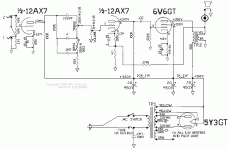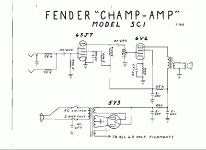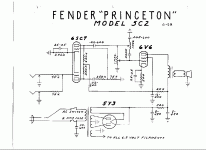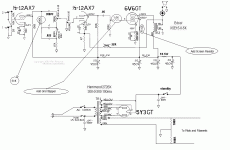I'd like to build something like a Champion 600 clone as a head with better bits, tube rectification and more Ohm taps, but still based off of a 6v6 or similar power tube, in the 5 watt range and ideally with tone controls instead of a tone stack and a genuine stand-by switch).
Oh yeah, this is my first tube project, and will be my most in depth project to date (I've changed pickups and built simple stuff on breadboards before, but no full-on projects).
I tried searching the forum for other similar projects but didn't come across anything. I admit that I may simply not know the right things to search for.
I have a friend that just graduated as an Electrical Engineer who is interested to help with the project because they didn't teach anything about tube electronics in his program at University, given that, Am I biting off too much? Has anybody built something like this, could the recommend schems or give me some guidance?
I keep thinking that maybe I should just mod a Champion, but it'd drive me nuts to end up throwing out 99.9% of the original parts to get it the way I actually want it, and heck, I'd rather have something of my own anyways.
If this has already been answered somewhere, I am very sorry, but I have been reading and searching on and off for a couple weeks now and haven't seen anything with the right focus or even dissimilar but with enough detail to piece it together.
Oh yeah, this is my first tube project, and will be my most in depth project to date (I've changed pickups and built simple stuff on breadboards before, but no full-on projects).
I tried searching the forum for other similar projects but didn't come across anything. I admit that I may simply not know the right things to search for.
I have a friend that just graduated as an Electrical Engineer who is interested to help with the project because they didn't teach anything about tube electronics in his program at University, given that, Am I biting off too much? Has anybody built something like this, could the recommend schems or give me some guidance?
I keep thinking that maybe I should just mod a Champion, but it'd drive me nuts to end up throwing out 99.9% of the original parts to get it the way I actually want it, and heck, I'd rather have something of my own anyways.
If this has already been answered somewhere, I am very sorry, but I have been reading and searching on and off for a couple weeks now and haven't seen anything with the right focus or even dissimilar but with enough detail to piece it together.
I was Just on my way to ZZZZZZ land, But I think I can offer you some ideas, I have built a heck of a lot of Champs.
I'll post a schematic in the morning. Its really a fun project.
Trout
I'll post a schematic in the morning. Its really a fun project.
Trout
OK,
Your goal is to build a Safe, Reliable, Low power guitar amp.
Easy enough. However, there are a few good starting points to take a serious look at prior to actually building this amplifier.
Tube amplifiers are powered by voltages & current that can and will KILL if not done properly.
You should really start by reading some of the safety information in the TUBE section of this forum.
Here
And
Here
That is with out a doubt a lot of reading, but think of it as a safety net.
Moving on.
There are a lot of well known designs that seem like they would meet your criteria. A simple vintage style Fender Champ is an excellent choice. There are lots of Kits in both Head and Combo versions available. You can also design your own head style amp and easily source the required parts.
I have found that as a first project, the Champ would give you the best chance of success.
It uses 1- 12AX7, 1- 6V6GT & 1-5Y3. There are only a handful of various parts needed and it can be built in a chassis as small as a Hammond 10 X 6 X 2, Or if you wish even a 12 X 8 X 2, The slightly larger size is a bit easier.
The most popular Champ had no tone control, but it was used to record some of the greatest rock tunes of all time.
5F1 Schematic
I have built a lot of a slightly more complicated Champs like the AA764 Blackface Champ
It has a basic control setup, Volume, Treble, Bass. Adding a standby switch to either model is a very simple task.
There are also lots of other great simple amps on the web, Check out AX84.com. They have a very comprehensive and detailed low power amp based on the EL84 output tube, some with solid state rectifiers.
Once you pick a project, Then 1/8th the work is done, There are that many variations.
Trout
Your goal is to build a Safe, Reliable, Low power guitar amp.
Easy enough. However, there are a few good starting points to take a serious look at prior to actually building this amplifier.
Tube amplifiers are powered by voltages & current that can and will KILL if not done properly.
You should really start by reading some of the safety information in the TUBE section of this forum.
Here
And
Here
That is with out a doubt a lot of reading, but think of it as a safety net.
Moving on.
There are a lot of well known designs that seem like they would meet your criteria. A simple vintage style Fender Champ is an excellent choice. There are lots of Kits in both Head and Combo versions available. You can also design your own head style amp and easily source the required parts.
I have found that as a first project, the Champ would give you the best chance of success.
It uses 1- 12AX7, 1- 6V6GT & 1-5Y3. There are only a handful of various parts needed and it can be built in a chassis as small as a Hammond 10 X 6 X 2, Or if you wish even a 12 X 8 X 2, The slightly larger size is a bit easier.
The most popular Champ had no tone control, but it was used to record some of the greatest rock tunes of all time.
5F1 Schematic
I have built a lot of a slightly more complicated Champs like the AA764 Blackface Champ
It has a basic control setup, Volume, Treble, Bass. Adding a standby switch to either model is a very simple task.
There are also lots of other great simple amps on the web, Check out AX84.com. They have a very comprehensive and detailed low power amp based on the EL84 output tube, some with solid state rectifiers.
Once you pick a project, Then 1/8th the work is done, There are that many variations.
Trout
Awesome, thanks! I'm trying to get a second amp about half as loud as my Reverberocket (50 watts) but with a similarish kind of tone. The only amps I've played that really speak to me seem to all have 6L6s or 6V6s in them. Maybe there's something else to it, but that's the only connection I'm aware of so far.
Borteep said:Awesome, thanks! I'm trying to get a second amp about half as loud as my Reverberocket (50 watts) but with a similarish kind of tone. The only amps I've played that really speak to me seem to all have 6L6s or 6V6s in them. Maybe there's something else to it, but that's the only connection I'm aware of so far.
You know,, It might be a good idea to look into one of the AX84 18W projects. Or possibly head over to 18watt.com and look into one of the 18W Marshall style amps. They have several versions including a lite version that has options on output tubes.
You will have to sign up to view anything, but its free and they have a good library with layouts & schematics.
Most of the work was based on a vintage 18W Marshall 1974X.
Great bunch of guys over there too, Very helpful.
Trout
Thanks for all the info. I've tried signing up at 18watts before and didn't get approved for whatever reason.
I like the looks of the AA764, I think I'll try to build a head version of that with 4/8/16 ohm speaker terminals and a standby switch once I finish doing my preparatory homework and find good sources for that parts.
What kind of speakers have you run yours through? Do you stay similar to stock and do 8 or 6 inch speakers? I was thinking of a 2x10 or 2x12 half-cab for it, though I've never played with speaker modifications or anything so I don't know what to expect from different speakers.
If I build a head cabinet and wrap it, are there limitations on the fabric I use? Any particular reason to stick to tolex or tweed?
I like the looks of the AA764, I think I'll try to build a head version of that with 4/8/16 ohm speaker terminals and a standby switch once I finish doing my preparatory homework and find good sources for that parts.
What kind of speakers have you run yours through? Do you stay similar to stock and do 8 or 6 inch speakers? I was thinking of a 2x10 or 2x12 half-cab for it, though I've never played with speaker modifications or anything so I don't know what to expect from different speakers.
If I build a head cabinet and wrap it, are there limitations on the fabric I use? Any particular reason to stick to tolex or tweed?
I have played with the AA764 for a good bit of time. I built mine as a tweed combo amp and sized the cab just big enough to use a 12 " speaker.
I am using a Jensen Neo 12/100 speaker for its high effiency and clarity.
I custom made my own eyelet board and made a few tweaks to the amp to allow use of 6L6GC or 6V6GT tubes.
Also made a couple tweaks to the tone stack.
Tweeding or Tolex either one is an art in itself, I am far better at applying tweed Vs tolex. So I use lots of tweed on my amps.
I opted to just use a single output tap, 8 ohm. If I wanted to use 2 speakers, I would just hook up (2)-16 ohms.
The real key to getting that amp to work well is in the power and output transformer. 75% of the builds I have seen pictures use to small of an output transformer.
Do a search on edcor here and you can see pictures of a really good transformer that is NOT expensive.
On mine I use a Hammond 272BX for power, It easily supplies enough voltage for running a 6L6GC.
Here are a couple clips from mine, The Distorted clips were done CRANKED, the other clips were done at about 6 on the volume knob.
opening stone riff
Various Champ Clips
Both of those were recorded close mic straight to PC, Flat EQ with no effects.
Trout
I am using a Jensen Neo 12/100 speaker for its high effiency and clarity.
I custom made my own eyelet board and made a few tweaks to the amp to allow use of 6L6GC or 6V6GT tubes.
Also made a couple tweaks to the tone stack.
Tweeding or Tolex either one is an art in itself, I am far better at applying tweed Vs tolex. So I use lots of tweed on my amps.
I opted to just use a single output tap, 8 ohm. If I wanted to use 2 speakers, I would just hook up (2)-16 ohms.
The real key to getting that amp to work well is in the power and output transformer. 75% of the builds I have seen pictures use to small of an output transformer.
Do a search on edcor here and you can see pictures of a really good transformer that is NOT expensive.
On mine I use a Hammond 272BX for power, It easily supplies enough voltage for running a 6L6GC.
Here are a couple clips from mine, The Distorted clips were done CRANKED, the other clips were done at about 6 on the volume knob.
opening stone riff
Various Champ Clips
Both of those were recorded close mic straight to PC, Flat EQ with no effects.
Trout
Those sound good!
I think I'll probably build a very low-efficiency cab first for recording.
Those Edcor look very good, if nothing else, but they also have a lot of good reviews.
I'll start a new thread once I finish reading some textbooks. So far a lot of the jargon is over my head. I could translate the schems and build something, but I'd like to have a bit of understanding of what is doing what 🙂 and why I'm doing the things I'm doing.
I think I'll probably build a very low-efficiency cab first for recording.
Those Edcor look very good, if nothing else, but they also have a lot of good reviews.
I'll start a new thread once I finish reading some textbooks. So far a lot of the jargon is over my head. I could translate the schems and build something, but I'd like to have a bit of understanding of what is doing what 🙂 and why I'm doing the things I'm doing.
Trout,
Those clips truly sound good! However I was wondering, how many watts does the Champ (EF1) out out is it 10W? I've been trying to find the output power specs on all the old fender amps but I can't seem to find them...Do you know where I could find them online?
On another note, what mic did you use to record those samples🙂
Borteep,
Greetings from Walla Walla! I'm quite a noobie myself and I know it can be hard to find info about this stuff. Since you are interested in the Champ and since it is a Class A single ended topology you should take a look at this for a VERY good explanation of how this topology works:
http://boozhoundlabs.com/howto/
Also check out :http://www.angelfire.com/electronic/funwithtubes/
for some great tutorials on power supply design etc.
I would also suggest purchasing Morgan Jones' Valve Amplifiers and its companion book Building Valve Amplifiers. This is how I started off and hopefully it sohlud get you going too..
Good luck...
Those clips truly sound good! However I was wondering, how many watts does the Champ (EF1) out out is it 10W? I've been trying to find the output power specs on all the old fender amps but I can't seem to find them...Do you know where I could find them online?
On another note, what mic did you use to record those samples🙂
Borteep,
Greetings from Walla Walla! I'm quite a noobie myself and I know it can be hard to find info about this stuff. Since you are interested in the Champ and since it is a Class A single ended topology you should take a look at this for a VERY good explanation of how this topology works:
http://boozhoundlabs.com/howto/
Also check out :http://www.angelfire.com/electronic/funwithtubes/
for some great tutorials on power supply design etc.
I would also suggest purchasing Morgan Jones' Valve Amplifiers and its companion book Building Valve Amplifiers. This is how I started off and hopefully it sohlud get you going too..
Good luck...
On another note, what mic did you use to record those samples
The Mic is an old Shure SM57 placed a couple inches from the front of the amp.
Those clips truly sound good! However I was wondering, how many watts does the Champ (EF1) out out is it 10W?
My best guess on the output is perhaps 4.5-5W using a single JJ6V6S with the edcor transformer.
Let me tell you, 5W is VERY loud, those dirty clips are with the amp cranked and you need to wear ear plugs when recording in a 12' X 15' room at those levels.
I have plugged these into cabs as big as 4 X 12" and it has no trouble driving them.
Trout
Trout said:
The Mic is an old Shure SM57 placed a couple inches from the front of the amp.
My best guess on the output is perhaps 4.5-5W using a single JJ6V6S with the edcor transformer.
Let me tell you, 5W is VERY loud, those dirty clips are with the amp cranked and you need to wear ear plugs when recording in a 12' X 15' room at those levels.
I have plugged these into cabs as big as 4 X 12" and it has no trouble driving them.
Trout
At 5 watts it should be roughly half the volume of my current 50 watt amplifier, if they were connected to the same speakers. That's why I'm going to be trying to find the lowest sensitivity speakers I can find. The speakers you are using approach 100 db sensitivity, so it shouldn't be too hard for me to find quieter speakers 😀
I just when through this with building a black face champ clone with my son.
5Y3 rectifier -> 1/2 6SL7 -> Princeton tone stack -> 1/2 6SL7 PI -> 6V6GT output.
I measured 3.4 watts before clipping. Since my son soldered it (I only did the mechanical work), he loves it.
Plus I used everything from the parts bin so it was *cheap*.
rick
5Y3 rectifier -> 1/2 6SL7 -> Princeton tone stack -> 1/2 6SL7 PI -> 6V6GT output.
I measured 3.4 watts before clipping. Since my son soldered it (I only did the mechanical work), he loves it.
Plus I used everything from the parts bin so it was *cheap*.
rick
I found a slightly clearer image of the schematic on a defunct website. It has a parts list and some other articles about tube theory as well.
So overall I'm ready to order the parts and start building, but I have one question: to insert a standby switch into the circuit I just have to introduce the switch into the yellow line off the transformer, right?
So overall I'm ready to order the parts and start building, but I have one question: to insert a standby switch into the circuit I just have to introduce the switch into the yellow line off the transformer, right?
Attachments
Borteep said:I have one question: to insert a standby switch into the circuit I just have to introduce the switch into the yellow line off the transformer, right?
I did not use a standby switch. If you do add it, it goes just before the first cap connection (see the 360v note on your schematic).
rick
I modded one of the above schematics to reflect exactly what values are in the amp used in my posted clips.
Note extra filter cap, tone stack value changes, grid stopper and screen resistor, 6.3V virtual CT, NFB resistor value change and standby switch.
The results are a simple 4-5W amp that really kicks, yet at idle you can not even tell its on.
I have hundreds of hours on this exact setup and would say it is pretty reliable and even better yet, sounds incredible. I am driving a Jensen Neo 12"/100w 98.8db speaker.
Trout
Note extra filter cap, tone stack value changes, grid stopper and screen resistor, 6.3V virtual CT, NFB resistor value change and standby switch.
The results are a simple 4-5W amp that really kicks, yet at idle you can not even tell its on.
I have hundreds of hours on this exact setup and would say it is pretty reliable and even better yet, sounds incredible. I am driving a Jensen Neo 12"/100w 98.8db speaker.
Trout
Attachments
Trout said:I modded one of the above schematics to reflect exactly what values are in the amp used in my posted clips.
Note extra filter cap, tone stack value changes, grid stopper and screen resistor, 6.3V virtual CT, NFB resistor value change and standby switch.
The results are a simple 4-5W amp that really kicks, yet at idle you can not even tell its on.
I have hundreds of hours on this exact setup and would say it is pretty reliable and even better yet, sounds incredible. I am driving a Jensen Neo 12"/100w 98.8db speaker.
Trout
Hello, toob noob here.
Why do you need the virtual ct for the heaters?
I have the case and transformers from a Bogen CHB-35a. The power transformer has 180vac with no ct and a 6.3vac winding with a ct. If i used SS rectification could i use these transformers for one of these small amps? What would i have to change in the power supply schematic here:
http://www.schematicheaven.com/hifiamps/bogen_chb35a.pdf
With full-wave rectification, the 180 volts will give you about 250volts, about 100 volts short of where the champ usually operates. It would work, but the power output would be greatly reduced.
The power supply as it is, is a but high, but a resitor could bring it down to about 350 volts for the champ circuit.
I am wondering: you have a push-pull amp with the Bogen, what about tweaking it for guitar use? A few changes here and there would make it a pretty decent guitar amp.
The virtual ground for heaters keeps the heater wires close to ground potential reducing the AC noise they induce. A center tap on the heater coil is best but the resistors work well too. Sometimes the resistors are replaced with a pot to adjust the hum rejection.
The power supply as it is, is a but high, but a resitor could bring it down to about 350 volts for the champ circuit.
I am wondering: you have a push-pull amp with the Bogen, what about tweaking it for guitar use? A few changes here and there would make it a pretty decent guitar amp.
The virtual ground for heaters keeps the heater wires close to ground potential reducing the AC noise they induce. A center tap on the heater coil is best but the resistors work well too. Sometimes the resistors are replaced with a pot to adjust the hum rejection.
- Status
- Not open for further replies.
- Home
- Live Sound
- Instruments and Amps
- Champion




